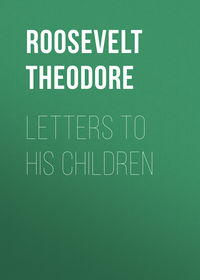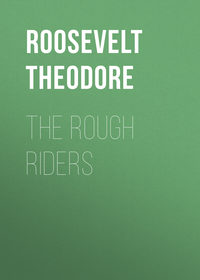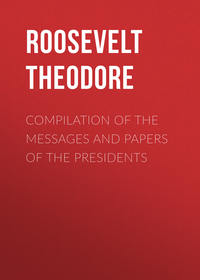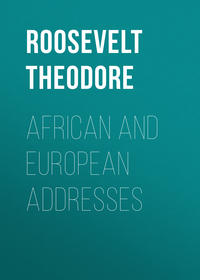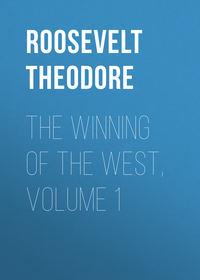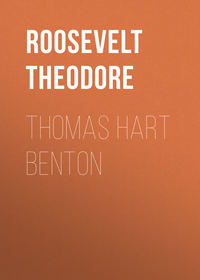 полная версия
полная версияThrough the Brazilian Wilderness
The native hunters who accompanied us were swarthy men of mixed blood. They were barefooted and scantily clad, and each carried a long, clumsy spear and a keen machete, in the use of which he was an expert. Now and then, in thick jungle, we had to cut out a path, and it was interesting to see one of them, although cumbered by his unwieldy spear, handling his half-broken little horse with complete ease while he hacked at limbs and branches. Of the two ordinarily with us one was much the younger; and whenever we came to an unusually doubtful- looking ford or piece of boggy ground the elder man always sent the younger one on and sat on the bank until he saw what befell the experimenter. In that rather preposterous book of our youth, the "Swiss Family Robinson," mention is made of a tame monkey called Nips, which was used to test all edible-looking things as to the healthfulness of which the adventurers felt doubtful; and because of the obvious resemblance of function we christened this younger hunter Nips. Our guides were not only hunters but cattle-herders. The coarse dead grass is burned to make room for the green young grass on which the cattle thrive. Every now and then one of the men, as he rode ahead of us, without leaving the saddle, would drop a lighted match into a tussock of tall dead blades; and even as we who were behind rode by tongues of hot flame would be shooting up and a local prairie fire would have started.
Kermit took Nips off with him for a solitary hunt one day. He shot two of the big marsh-deer, a buck and a doe, and preserved them as museum specimens. They were in the papyrus growth, but their stomachs contained only the fine marsh-grass which grows in the water and on the land along the edges of the swamps; the papyrus was used only for cover, not for food. The buck had two big scent-glands beside the nostrils; in the doe these were rudimentary. On this day Kermit also came across a herd of the big, fierce white-lipped peccary; at the sound of their grunting Nips promptly spurred his horse and took to his heels, explaining that the peccaries would charge them, hamstring the horses, and kill the riders. Kermit went into the jungle after the truculent little wild hogs on foot and followed them for an hour, but never was able to catch sight of them.
In the afternoon of this same day one of the jaguar-hunters—merely ranch hands, who knew something of the chase of the jaguar—who had been searching for tracks, rode in with the information that he had found fresh sign at a spot in the swamp about nine miles distant. Next morning we rose at two, and had started on our jaguar-hunt at three. Colonel Rondon, Kermit, and I, with the two trailers or jaguar- hunters, made up the party, each on a weedy, undersized marsh pony, accustomed to traversing the vast stretches of morass; and we were accompanied by a brown boy, with saddle-bags holding our lunch, who rode a long-horned trotting steer which he managed by a string through its nostril and lip. The two trailers carried each a long, clumsy spear. We had a rather poor pack. Besides our own two dogs, neither of which was used to jaguar-hunting, there were the ranch dogs, which were well-nigh worthless, and then two jaguar hounds borrowed for the occasion from a ranch six or eight leagues distant. These were the only hounds on which we could place any trust, and they were led in leashes by the two trailers. One was a white bitch, the other, the best one we had, was a gelded black dog. They were lean, half-starved creatures with prick ears and a look of furtive wildness.
As our shabby little horses shuffled away from the ranch-house the stars were brilliant and the Southern Cross hung well up in the heavens, tilted to the right. The landscape was spectral in the light of the waning moon. At the first shallow ford, as horses and dogs splashed across, an alligator, the jacare-tinga, some five feet long, floated unconcernedly among the splashing hoofs and paws; evidently at night it did not fear us. Hour after hour we slogged along. Then the night grew ghostly with the first dim gray of the dawn. The sky had become overcast. The sun rose red and angry through broken clouds; his disk flamed behind the tall, slender columns of the palms, and lit the waste fields of papyrus. The black monkeys howled mournfully. The birds awoke. Macaws, parrots, parakeets screamed at us and chattered at us as we rode by. Ibis called with wailing voices, and the plovers shrieked as they wheeled in the air. We waded across bayous and ponds, where white lilies floated on the water and thronging lilac-flowers splashed the green marsh with color.
At last, on the edge of a patch of jungle, in wet ground, we came on fresh jaguar tracks. Both the jaguar hounds challenged the sign. They were unleashed and galloped along the trail, while the other dogs noisily accompanied them. The hunt led right through the marsh. Evidently the jaguar had not the least distaste for water. Probably it had been hunting for capybaras or tapirs, and it had gone straight through ponds and long, winding, narrow ditches or bayous, where it must now and then have had to swim for a stroke or two. It had also wandered through the island-like stretches of tree-covered land, the trees at this point being mostly palms and tarumans; the taruman is almost as big as a live-oak, with glossy foliage and a fruit like an olive. The pace quickened, the motley pack burst into yelling and howling; and then a sudden quickening of the note showed that the game had either climbed a tree or turned to bay in a thicket. The former proved to be the case. The dogs had entered a patch of tall tree jungle, and as we cantered up through the marsh we saw the jaguar high among the forked limbs of a taruman tree. It was a beautiful picture— the spotted coat of the big, lithe, formidable cat fairly shone as it snarled defiance at the pack below. I did not trust the pack; the dogs were not stanch, and if the jaguar came down and started I feared we might lose it. So I fired at once, from a distance of seventy yards. I was using my favorite rifle, the little Springfield with which I have killed most kinds of African game, from the lion and elephant down; the bullets were the sharp, pointed kind, with the end of naked lead. At the shot the jaguar fell like a sack of sand through the branches, and although it staggered to its feet it went but a score of yards before it sank down, and when I came up it was dead under the palms, with three or four of the bolder dogs riving at it.
The jaguar is the king of South American game, ranking on an equality with the noblest beasts of the chase of North America, and behind only the huge and fierce creatures which stand at the head of the big game of Africa and Asia. This one was an adult female. It was heavier and more powerful than a full-grown male cougar, or African panther or leopard. It was a big, powerfully built creature, giving the same effect of strength that a tiger or lion does, and that the lithe leopards and pumas do not. Its flesh, by the way, proved good eating, when we had it for supper, although it was not cooked in the way it ought to have been. I tried it because I had found cougars such good eating; I have always regretted that in Africa I did not try lion's flesh, which I am sure must be excellent.
Next day came Kermit's turn. We had the miscellaneous pack with us, all much enjoying themselves; but, although they could help in a jaguar-hunt to the extent of giving tongue and following the chase for half a mile, cowing the quarry by their clamor, they were not sufficiently stanch to be of use if there was any difficulty in the hunt. The only two dogs we could trust were the two borrowed jaguar hounds. This was the black dog's day. About ten in the morning we came to a long, deep, winding bayou. On the opposite bank stood a capybara, looking like a blunt-nosed pig, its wet hide shining black. I killed it, and it slid into the water. Then I found that the bayou extended for a mile or two in each direction, and the two hunter-guides said they did not wish to swim across for fear of the piranhas. Just at this moment we came across fresh jaguar tracks. It was hot, we had been travelling for five hours, and the dogs were much exhausted. The black hound in particular was nearly done up, for he had been led in a leash by one of the horsemen. He lay flat on the ground, panting, unable to catch the scent. Kermit threw water over him, and when he was thoroughly drenched and freshened, thrust his nose into the jaguar's footprints. The game old hound at once and eagerly responded. As he snuffed the scent he challenged loudly, while still lying down. Then he staggered to his feet and started on the trail, going stronger with every leap. Evidently the big cat was not far distant. Soon we found where it had swum across the bayou. Piranhas or no piranhas, we now intended to get across; and we tried to force our horses in at what seemed a likely spot. The matted growth of water-plants, with their leathery, slippery stems, formed an unpleasant barrier, as the water was swimming-deep for the horses. The latter were very unwilling to attempt the passage. Kermit finally forced his horse through the tangled mass, swimming, plunging, and struggling. He left a lane of clear water, through which we swam after him. The dogs splashed and swam behind us. On the other bank they struck the fresh trail and followed it at a run. It led into a long belt of timber, chiefly composed of low-growing nacury palms, with long, drooping, many- fronded branches. In silhouette they suggest coarse bamboos; the nuts hang in big clusters and look like bunches of small, unripe bananas. Among the lower palms were scattered some big ordinary trees. We cantered along outside the timber belt, listening to the dogs within; and in a moment a burst of yelling clamor from the pack told that the jaguar was afoot. These few minutes are the really exciting moments in the chase, with hounds, of any big cat that will tree. The furious baying of the pack, the shouts and cheers of encouragement from the galloping horsemen, the wilderness surroundings, the knowledge of what the quarry is—all combine to make the moment one of fierce and thrilling excitement. Besides, in this case there was the possibility the jaguar might come to bay on the ground, in which event there would be a slight element of risk, as it might need straight shooting to stop a charge. However, about as soon as the long-drawn howling and eager yelping showed that the jaguar had been overtaken, we saw him, a huge male, up in the branches of a great fig-tree. A bullet behind the shoulder, from Kermit's 405 Winchester, brought him dead to the ground. He was heavier than the very big male horse-killing cougar I shot in Colorado, whose skull Hart Merriam reported as the biggest he had ever seen; he was very nearly double the weight of any of the male African leopards we shot; he was nearly or quite the weight of the smallest of the adult African lionesses we shot while in Africa. He had the big bones, the stout frame, and the heavy muscular build of a small lion; he was not lithe and slender and long like a cougar or leopard; the tail, as with all jaguars, was short, while the girth of the body was great; his coat was beautiful, with a satiny gloss, and the dark-brown spots on the gold of his back, head, and sides were hardly as conspicuous as the black of the equally well-marked spots against his white belly.
This was a well-known jaguar. He had occasionally indulged in cattle- killing; on one occasion during the floods he had taken up his abode near the ranch-house and had killed a couple of cows and a young steer. The hunters had followed him, but he had made his escape, and for the time being had abandoned the neighborhood. In these marshes each jaguar had a wide irregular range and travelled a good deal, perhaps only passing a day or two in a given locality, perhaps spending a week where game was plentiful. Jaguars love the water. They drink greedily and swim freely. In this country they rambled through the night across the marshes and prowled along the edges of the ponds and bayous, catching the capybaras and the caymans; for these small pond caymans, the jacare-tinga, form part of their habitual food, and a big jaguar when hungry will attack and kill large caymans and crocodiles if he can get them a few yards from the water. On these marshes the jaguars also followed the peccary herds; it is said that they always strike the hindmost of a band of the fierce little wild pigs. Elsewhere they often prey on the tapir. If in timber, however, the jaguar must kill it at once, for the squat, thick-skinned, wedge- shaped tapir has no respect for timber, as Colonel Rondon phrased it, and rushes with such blind, headlong speed through and among branches and trunks that if not immediately killed it brushes the jaguar off, the claws leaving long raking scars in the tough hide. Cattle are often killed. The jaguar will not meddle with a big bull; and is cautious about attacking a herd accompanied by a bull; but it will at times, where wild game is scarce, kill every other domestic animal. It is a thirsty brute, and if it kills far from water will often drag its victim a long distance toward a pond or stream; Colonel Rondon had once come across a horse which a jaguar had thus killed and dragged for over a mile. Jaguars also stalk and kill the deer; in this neighborhood they seemed to be less habitual deer-hunters than the cougars; whether this is generally the case I cannot say. They have been known to pounce on and devour good-sized anacondas.
In this particular neighborhood the ordinary jaguars molested the cattle and horses hardly at all except now and then to kill calves. It was only occasionally that under special circumstances some old male took to cattle-killing. There were plenty of capybaras and deer, and evidently the big spotted cats preferred the easier prey when it was available; exactly as in East Africa we found the lions living almost exclusively on zebra and antelope, and not molesting the buffalo and domestic cattle, which in other parts of Africa furnish their habitual prey. In some other neighborhoods, not far distant, our hosts informed us that the jaguars lived almost exclusively on horses and cattle. They also told us that the cougars had the same habits as the jaguars except that they did not prey on such big animals. The cougars on this ranch never molested the foals, a fact which astonished me, as in the Rockies they are the worst enemies of foals. It was interesting to find that my hosts, and the mixed-blood hunters and ranch workers, combined special knowledge of many of the habits of these big cats with a curious ignorance of other matters concerning them and a readiness to believe fables about them. This was precisely what I had found to be the case with the old-time North American hunters in discussing the puma, bear, and wolf, and with the English and Boer hunters of Africa when they spoke of the lion and rhinoceros. Until the habit of scientific accuracy in observation and record is achieved and until specimens are preserved and carefully compared, entirely truthful men, at home in the wilderness, will whole-heartedly accept, and repeat as matters of gospel faith, theories which split the grizzly and black bears of each locality in the United States, and the lions and black rhinos of South Africa, or the jaguars and pumas of any portion of South America, into several different species, all with widely different habits. They will, moreover, describe these imaginary habits with such sincerity and minuteness that they deceive most listeners; and the result sometimes is that an otherwise good naturalist will perpetuate these fables, as Hudson did when he wrote of the puma. Hudson was a capital observer and writer when he dealt with the ordinary birds and mammals of the well-settled districts near Buenos Aires and at the mouth of the Rio Negro; but he knew nothing of the wilderness. This is no reflection on him; his books are great favorites of mine, and are to a large degree models of what such books should be; I only wish that there were hundreds of such writers and observers who would give us similar books for all parts of America. But it is a mistake to accept him as an authority on that concerning which he was ignorant.
An interesting incident occurred on the day we killed our first jaguar. We took our lunch beside a small but deep and obviously permanent pond. I went to the edge to dip up some water, and something growled or bellowed at me only a few feet away. It was a jacare-tinga or small cayman about five feet long. I paid no heed to it at the moment. But shortly afterward when our horses went down to drink it threatened them and frightened them; and then Colonel Rondon and Kermit called me to watch it. It lay on the surface of the water only a few feet distant from us and threatened us; we threw cakes of mud at it, whereupon it clashed its jaws and made short rushes at us, and when we threw sticks it seized them and crunched them. We could not drive it away. Why it should have shown such truculence and heedlessness I cannot imagine, unless perhaps it was a female, with eggs near by. In another little pond a jacare-tinga showed no less anger when another of my companions approached. It bellowed, opened its jaws, and lashed its tail. Yet these pond jacares never actually molested even our dogs in the ponds, far less us on our horses.
This same day others of our party had an interesting experience with the creatures in another pond. One of them was Commander da Cunha (of the Brazilian Navy), a capital sportsman and delightful companion. They found a deepish pond a hundred yards or so long and thirty or forty across. It was tenanted by the small caymans and by capybaras— the largest known rodent, a huge aquatic guinea-pig, the size of a small sheep. It also swarmed with piranhas, the ravenous fish of which I have so often spoken. Undoubtedly the caymans were subsisting largely on these piranhas. But the tables were readily turned if any caymans were injured. When a capybara was shot and sank in the water, the piranhas at once attacked it, and had eaten half the carcass ten minutes later. But much more extraordinary was the fact that when a cayman about five feet long was wounded the piranhas attacked and tore it, and actually drove it out on the bank to face its human foes. The fish first attacked the wound; then, as the blood maddened them, they attacked all the soft parts, their terrible teeth cutting out chunks of tough hide and flesh. Evidently they did not molest either cayman or capybara while it was unwounded; but blood excited them to frenzy. Their habits are in some ways inexplicable. We saw men frequently bathing unmolested; but there are places where this is never safe, and in any place if a school of the fish appear swimmers are in danger; and a wounded man or beast is in deadly peril if piranhas are in the neighborhood. Ordinarily it appears that an unwounded man is attacked only by accident. Such accidents are rare; but they happen with sufficient frequency to justify much caution in entering water where piranhas abound.
We frequently came across ponds tenanted by numbers of capybaras. The huge, pig-like rodents are said to be shy elsewhere. Here they were tame. The water was their home and refuge. They usually went ashore to feed on the grass, and made well-beaten trails in the marsh immediately around the water; but they must have travelled these at night, for we never saw them more than a few feet away from the water in the daytime. Even at midday we often came on them standing beside a bayou or pond. The dogs would rush wildly at such a standing beast, which would wait until they were only a few yards off and then dash into and under the water. The dogs would also run full tilt into the water, and it was then really funny to see their surprise and disappointment at the sudden and complete disappearance of their quarry. Often a capybara would stand or sit on its haunches in the water, with only its blunt, short-eared head above the surface, quite heedless of our presence. But if alarmed it would dive, for capybaras swim with equal facility on or below the surface; and if they wish to hide they rise gently among the rushes or water-lily leaves with only their nostrils exposed. In these waters the capybaras and small caymans paid no attention to one another, swimming and resting in close proximity. They both had the same enemy, the jaguar. The capybara is a game animal only in the sense that a hare or rabbit is. The flesh is good to eat, and its amphibious habits and queer nature and surroundings make it interesting. In some of the ponds the water had about gone, and the capybaras had become for the time being beasts of the marsh and the mud; although they could always find little slimy pools, under a mass of water-lilies, in which to lie and hide.
Our whole stay on this ranch was delightful. On the long rides we always saw something of interest, and often it was something entirely new to us. Early one morning we came across two armadillos—the big, nine-banded armadillo. We were riding with the pack through a dry, sandy pasture country, dotted with clumps of palms, round the trunks of which grew a dense jungle of thorns and Spanish bayonets. The armadillos were feeding in an open space between two of these jungle clumps, which were about a hundred yards apart. One was on all fours; the other was in a squatting position, with its fore legs off the ground. Their long ears were very prominent. The dogs raced at them. I had always supposed that armadillos merely shuffled along, and curled up for protection when menaced; and I was almost as surprised as if I had seen a turtle gallop when these two armadillos bounded off at a run, going as fast as rabbits. One headed back for the nearest patch of jungle, which it reached. The other ran at full speed—and ran really fast, too—until it nearly reached the other patch, a hundred yards distant, the dogs in full cry immediately behind it. Then it suddenly changed its mind, wheeled in its tracks, and came back like a bullet right through the pack. Dog after dog tried to seize it or stop it and turned to pursue it; but its wedge-shaped snout and armored body, joined to the speed at which it was galloping, enabled it to drive straight ahead through its pursuers, not one of which could halt it or grasp it, and it reached in safety its thorny haven of refuge. It had run at speed about a hundred and fifty yards. I was much impressed by this unexpected exhibition; evidently this species of armadillo only curls up as a last resort, and ordinarily trusts to its speed, and to the protection its build and its armor give it while running, in order to reach its burrow or other place of safety. Twice, while laying railway tracks near Sao Paulo, Kermit had accidentally dug up armadillos with a steam-shovel.
There were big ant-hills, some of them of huge dimensions, scattered through the country. Sometimes they were built against the stems of trees. We did not here come across any of the poisonous or biting ants which, when sufficiently numerous, render certain districts uninhabitable. They are ordinarily not very numerous. Those of them that march in large bodies kill nestling birds, and at once destroy any big animal unable to get out of their way. It has been suggested that nestlings in their nests are in some way immune from the attack of these ants. The experiments of our naturalists tended to show that this was not the case. They plundered any nest they came across and could get at.
Once we saw a small herd of peccaries, one a sow followed by three little pigs—they are said to have only two young, but we saw three, although of course it is possible one belonged to another sow. The herd galloped into a mass of thorny cover the hounds could not penetrate; and when they were in safety we heard them utter, from the depths of the jungle, a curious moaning sound.
On one ride we passed a clump of palms which were fairly ablaze with bird color. There were magnificent hyacinth macaws; green parrots with red splashes; toucans with varied plumage, black, white, red, yellow; green jacmars; flaming orioles and both blue and dark-red tanagers. It was an extraordinary collection. All were noisy. Perhaps there was a snake that had drawn them by its presence; but we could find no snake. The assembly dispersed as we rode up; the huge blue macaws departed in pairs, uttering their hoarse "ar-rah-h, ar-rah-h." It has been said that parrots in the wilderness are only noisy on the wing. They are certainly noisy on the wing; and those that we saw were quiet while they were feeding; but ordinarily when they were perched among the branches, and especially when, as in the case of the little parakeets near the house, they were gathering materials for nest-building, they were just as noisy as while flying.


